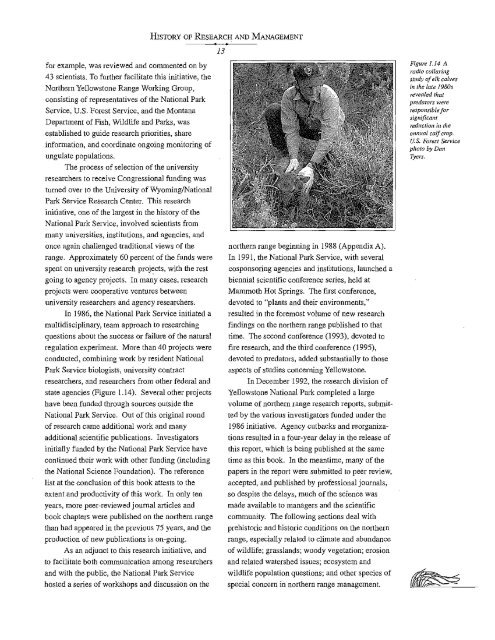Yellowstone's Northern Range - Greater Yellowstone Science ...
Yellowstone's Northern Range - Greater Yellowstone Science ...
Yellowstone's Northern Range - Greater Yellowstone Science ...
Create successful ePaper yourself
Turn your PDF publications into a flip-book with our unique Google optimized e-Paper software.
HISTORY OF REsEARCH AND MANAGEMENT<br />
for example, was reviewed and commented on by<br />
43 scientists. To further facilitate this initiative, the<br />
<strong>Northern</strong> <strong>Yellowstone</strong> <strong>Range</strong> Working Group,<br />
consisting of representatives of the National Park<br />
Service, U.S. Forest Service, and the Montana<br />
Department of Fish, Wildlife and Parks, was<br />
established to guide research priorities, share<br />
information, and coordinate ongoing monitoring of<br />
ungulate populations.<br />
The process of selection of the university<br />
researchers to receive Congressional funding was<br />
turned over to the University of WyomingiNational<br />
Park Service Research Center. This research<br />
initiative, one of the largest in the history of the<br />
National Park Service, involved scientists from<br />
many universities, institutions, and agencies, and<br />
once again challenged traditional views of the<br />
range. Approximately 60 percent of the funds were<br />
spent on university research proj~cts, with the rest<br />
going to agency projects. In many cases, research<br />
projects were cooperative ventures between<br />
university researchers and agency researchers.<br />
In 1986, the National Park Service initiated a<br />
multidisciplinary, team approach to researching<br />
questions about the success or failure of the natural<br />
regulation experiment. More than 40 projects were<br />
conducted, combining work by resident National<br />
Park Service biologists, university contract<br />
researchers, and researchers from other federal and<br />
state agencies (Figure l.14). Several other projects<br />
have been funded through sources outside the<br />
National Park Service. Out of this original round<br />
of research came additional work and many<br />
additional scientific publications. Investigators<br />
initially funded by the National Park Service have<br />
continued their work with other funding (including<br />
the National <strong>Science</strong> Foundation). The reference<br />
list at the conclusion of this book attests to the<br />
extent and productivity of this work. In only ten<br />
years, more peer-reviewed journal articles and<br />
book chapters were published on the northern range<br />
than had appeared in the previous 75 years, and the<br />
production of new publications is on-going.<br />
As an adjunct to this research initiative, and<br />
to facilitate both communication among researchers<br />
and with the public, the National Park Service<br />
hosted a series of workshops and discussion on the<br />
13<br />
northern range beginrting in 1988 (Appendix A).<br />
In 1991, the National Park Service, with several<br />
cosponsoring agencies and institutions, launched a<br />
biennial scientific conference series, held at<br />
Mammoth Hot Springs. The first conference,<br />
devoted to "plants and their environments,"<br />
resulted in the foremost volume of new research<br />
findings on the northern range published to that<br />
time. The second conference (1993), devoted to<br />
fire research, and the third conference (1995),<br />
devoted to predators, added substantially to those<br />
aspects of studies concerning <strong>Yellowstone</strong>.<br />
In December 1992, the research division of<br />
<strong>Yellowstone</strong> National Park completed a large<br />
volume of northern range research reports, submitted<br />
by the various investigators funded under the<br />
1986 initiative. Agency cutbacks and reorganizations<br />
resulted in a four-year delay in the release of<br />
this report, which is being published at the same<br />
time as this book. In the meantime, many of the<br />
papers in the report were submitted to peer review,<br />
accepted, and published by professional journals,<br />
so despite the delays, much of the science was<br />
made available to managers and the scientific<br />
community. The following sections deal with<br />
prehistoric and historic conditions on the northern<br />
range, especially related to climate and abundance<br />
of wildlife; grasslands; woody vegetation; erosion<br />
and related watershed issues; ecosystem and<br />
wildlife population questions; and other species of<br />
special concern in northern range management.<br />
Figure 1.14 A<br />
radio collaring<br />
study of elk calves<br />
in the late 1980s<br />
revealed that<br />
predators were<br />
responsible for<br />
significant<br />
reduction in/he<br />
annual calf crop.<br />
U.S. Forest Service<br />
photo by Dan<br />
Tyers.















